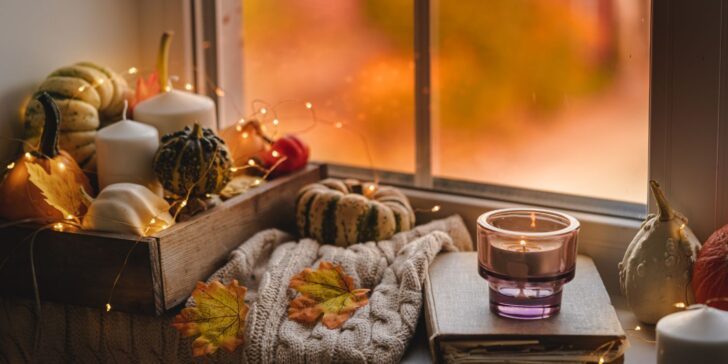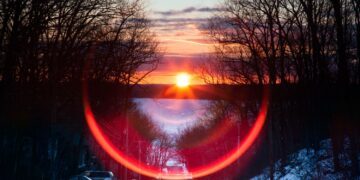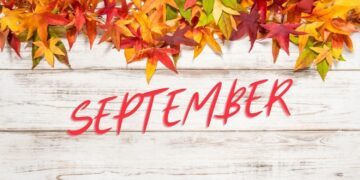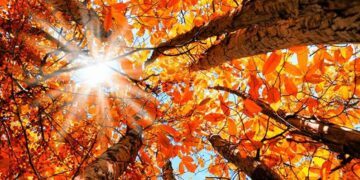The fall equinox marks the transition to a new season. Summer is truly over, and the weather is getting cooler day by day. Some people also see this time of year as a new beginning.
No matter which part of the world you live in, there are plenty of cozy facts about the fall equinox.
If you’re curious to know more, keep on reading!
The Sun is positioned exactly above the Equator during the fall equinox. This happens on September 22 or 23 in the Northern Hemisphere and March 20 or 21 in the Southern Hemisphere.
Because of its direct position in relation to the Equator during an equinox, the Sun rises almost exactly in the east and sets almost exactly in the west. This happens for everyone, no matter where you are in the world.
The word equinox means “equal night”. This has led many people to believe day and night are equal during the fall equinox, but they’re not. They’re truly equal on the equilux, which occurs within a few days of the equinox.
A Harvest Moon is the full moon seen nearest to the date of the fall equinox. It may appear bigger and brighter and might even look red or orange.
During the fall equinox, people in the Northern Hemisphere might see fascinating displays of the Aurora Borealis, or Northern Lights. This is because there are double the number of geomagnetic storms in September as the Sun sends more solar wind toward the Earth.
Although we usually mark the fall equinox on September 22 or 23 in the Northern Hemisphere, it occasionally happens on September 24. The last time this happened was in 1931. It will happen again in the year 2303.
The fall equinox in the Northern Hemisphere may fall on September 21, but this has not happened for thousands of years. It will happen twice during the 21st century, in 2092 and 2096.
During the French Revolution, the government created a new national calendar. It began on the day the French Republic was announced, the fall equinox of 1792, which fell on September 22.
Mabon is a harvest festival celebrated during the fall equinox. It is anglo pagan holiday and marks the second harvest when farmers see how well their crops are growing.
In Japan, the fall equinox is marked by Higan, a Buddhist holiday that lasts for seven days. Higan runs from three days before to three days after both the fall equinox and spring equinox. One way to mark this occasion is by eating rice cakes known as ohagi.
People gather at Stonehenge, a famous landmark in England, UK, on the morning of the fall equinox. It is particularly popular with pagans and druids, who come to watch the Sun rise over the large stones.
In China, people remember lost loved ones during the Mid-Autumn Festival, celebrated around the fall equinox. The festival’s history lies in the story of the brave warrior Houyi, whose lover Chang’e was taken from him and is believed to live on the moon.
September, the month of the fall equinox in the Northern Hemisphere, is the most popular month for babies to be born in America. Almost all the most popular birth dates fall between September 9-20, just before the equinox.
An equinox differs from a solstice, though they are often mistakenly used interchangeably. The two equinoxes occur in fall and spring, while the two solstices mark the beginning of summer and winter.
The days get shorter, and the nights become longer after the fall equinox in the Northern Hemisphere. This can impact your body’s internal clock, and you might notice changes in your sleep pattern or mood.
In Greek mythology, the goddess Persephone returns to the underworld during the fall equinox, where she reunites with her husband, Hades, the god of the underworld.
Many people see the fall equinox as a moment of balance. The Earth is split between the north and south and between warm and cold. The day is divided almost equally into day and night.
Animals begin to hibernate in some countries when the fall equinox comes. You might also see chipmunks, squirrels, and other animals store food in preparation for the colder months ahead.
American poet Elizabeth Alexander wrote a poem titled Equinox in September 1993, in which she describes how bees die at the end of September as the weather gets colder.
People gather at Woodhenge, a historical landmark in Illinois, to mark the fall equinox. This famous circle of posts was used by Native Americans as a calendar. People can watch the sunrise on the same ground where Mississippian people observed it many years ago.

The fall equinox is a unique moment experienced by everyone in the world. From beautiful sunrises to stunning light displays, it is certainly a moment to behold.
People have been marking the changes in seasons for thousands of years. Each country and culture has its own way of celebrating the fall equinox.
Whether you’ve enjoyed a fall equinox sunrise or want to get ready for the next one, you now know more than ever about this natural phenomenon!


















